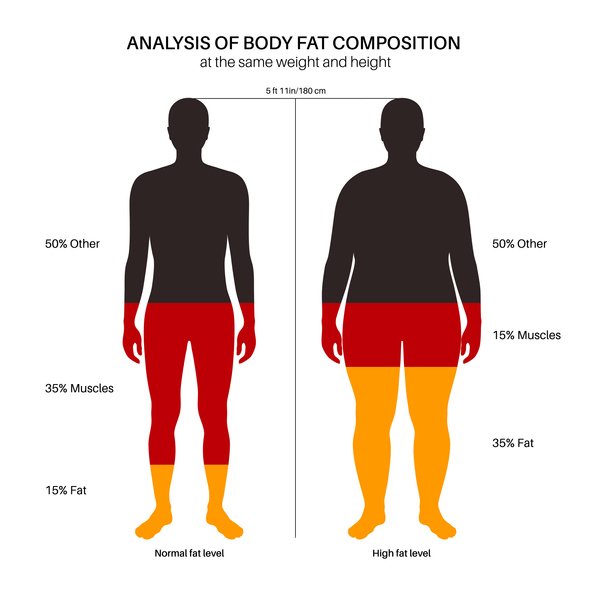Waist-To-Height Ratio: An Easy Way To Determine Your Cardiometabolic Risk
A few years back, I wrote about the negative health consequences of visceral fat, which is the kind of fat that surrounds our organs. Too much of it is bad for our health. You can read my previous post on it here. I spoke about several ways to measure it, but I want to concentrate on one very easy and free method called the waist-to-height ratio. Later, I will show you how to measure yours to determine your health risk.
Belly Fat, Waist Measurement, and Disease
The correlation between obesity and disease is well established. Diabetes and heart disease are two of the most prevalent conditions associated with obesity and poor health. Together, they represent the two biggest cardiometabolic risks for our health. Most fat distributes around the waist so that waist measurement methods can be useful. An early method was the waist-to-hip ratio developed by Gothenburg and associates. 1,2 In 1995, Hsieh and Yoshinaga used waist measurements from over three thousand men to determine whether there is any correlation between the waist-to-hip ratio and cardiometabolic risk factor levels. They included blood pressure, fasting blood glucose, hemoglobin A1c (HbA1c), triglyceride, cholesterol, HDL cholesterol values, and the risk factor morbidity index parameters that included hypertension and abnormal glucose tolerance hypertriglyceridemia, hypercholesterolemia, and low HDL cholesterol. Sadly, they found that the waist-to-hip ratio was not significantly associated with most variables.
The Problem With BMI
Although fairly accurate at higher levels, BMI (body mass index) has proven problematic at moderate levels and decreases in accuracy with older subjects. The problem with BMI is that those with more musculature will falsely register as having a higher BMI because the BMI calculation assumes similar muscularity for all people. Conversely, people with less muscle, like seniors, can carry more fat and still register as having a normal BMI. 3 A paper by Abramowitz, Hall, Amodu, and colleagues from 2018 studied the appendicular skeletal muscle mass index, which is a fancy way of measuring muscle mass. The researchers concluded that BMI does not correlate to disease risks after accounting for increased muscle mass. 4
Waist To Height Ratio
The same researchers who found the waist-to-hip ratio to be of little value determined that the waist-to-height ratio (WTHR, also WHtR) has a high correlation to disease. In 2005, Ashwell and Hsei suggested that it is superior to BMI and other methods for several reasons:
WHTR is more sensitive than BMI as an early warning of health risks.
WHTR is cheaper and easier to measure and calculate than BMI.
It is useful for both men and women.
It is useful across different ethnic groups.
WHTR is a free consumer-friendly concept.
WHTR may be useful for both children and adults. 5
How To Calculate Your WTHR
To determine your WTHR, measure your waist circumference and divide it by your height. For instance, if you are six feet tall and have a waist circumference of 36 inches, divide 36 inches by 72 inches. Your ratio will be .5, or 50%. You can use this online WTHR calculator to see what your ratio is.
What Is a Good WTHR?
A systematic review and meta-analysis revealed a value of 0.5 (50%) to be of global application to identify an increased cardiovascular and metabolic risk. It is the only number to know. If you are below it, you are ok. Higher is considered a risk factor for cardiovascular disease, metabolic disorders, and other cardiometabolic diseases. 6 BMIcalculator.net has a few more categories: 34% and below are considered extremely thin, 35% to 42% are healthy slim, 43% to 52% are healthy, 53% to 57% is overweight, 58% to 62% is considered very overweight, and 63% and over is considered morbidly obese.
My Example
My BMI is 23.57. A BMI of 24.9 is considered overweight. I am near the limit but nowhere close to being overweight. I do daily resistance training, which skews my BMI result. On the other hand, my WTHR is 44.12%, well below the 50% mark, making it a more reasonable measure than BMI in my case. My BMI has me within about a 5% margin for being considered overweight, whereas my WTHR is 12% below the problematic 50% cutoff.
What You Can Do To Lower Your WTHR
There are options for those of you who may be above the 50% WTHR. I am not a fan of losing weight as a singular goal. I recommend putting these seven things in order:
Oxygen (healthy breathing)
Good sleep
Stress reduction
Proper nutrient intake
Regular healthy movement
Maintaining healthy nurturing relationships
Getting regular non-burning sun
You can learn more about the importance of these seven things in this post. When we put all of these ingredients into practice, we will tend to lose visceral fat and become happier, healthier, and more vibrant.






